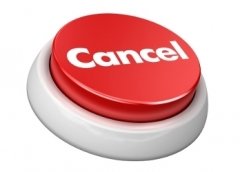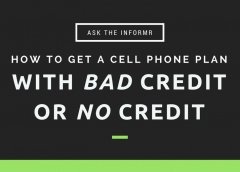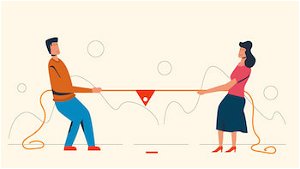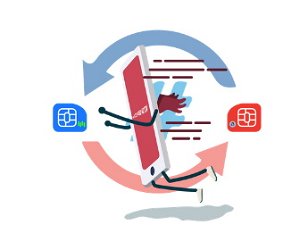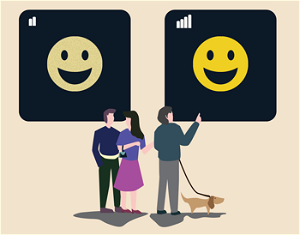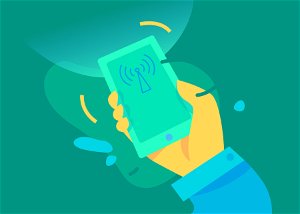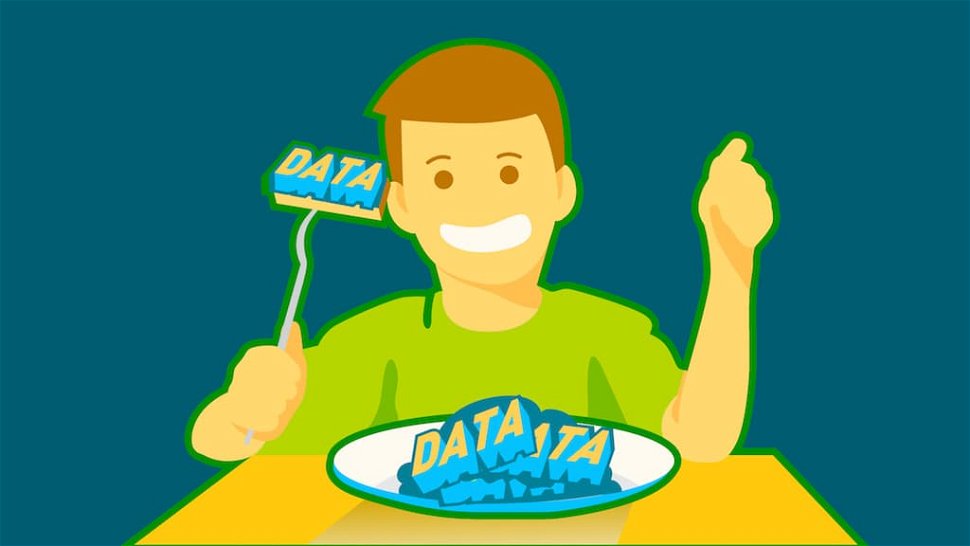
So you signed up for a smartphone contract and jumped into the world of candy crush and snapchats on the go.
You’ve already watched your favorite TV show on the train, sent selfies to everyone on your contact list and even finished up that work project from the clubhouse.
This data thing is pretty awesome!

Then a text message arrives.

“You’ve used about 90% of your data plan.”
What? How did that happened!?
Don't worry. We've been there. Lets take a look at just how much smartphone data you really need and talk about a few ways you can keep usage in check.
What is This Data Stuff Anyway?
Before we can determine how much data you need, knowing a bit about what it is might help. Let's cover a few of the basics.
Any time that your phone is transmitting or receiving information, it does so using data. At it’s simplest, data is the digital stuff that makes up your pictures, audio, video or anything else on your phone.
Your carrier will determine what type of data it charges for. For example, most don’t charge you for the data required to transmit your call. They also won’t charge you for the data to send a text if you have a texting plan.
For the purposes of this guide, we’ll be talking about all that other data. The stuff typically covered by data bundles or data plans.
Most often, data is sold in megabytes (MB) or gigabytes (GB). This is a basic unit of measurement. There’s roughly 1,000 kilobytes (KB) in 1MB, 1,000MB in 1GB and so on.
 Bigger measurements exist, but the thought of seeing the bill for that level of usage is too terrifying to talk about.
Bigger measurements exist, but the thought of seeing the bill for that level of usage is too terrifying to talk about.
Plans typically come in one of two types:
- single line
- shared
These work exactly like they sound and if you do have more than one line (phone number) on a plan, the shared plans are almost always a cheaper option per MB or GB.
If you exceed your allowance, your carrier will likely automatically charge you for extra data at an elevated rate. So choosing the proper data plan is essential for minimizing costs.
So How Much Data Does the Average Person Really Need?
Queue the researchers.
According to a Neilson study in 2013, the average subscriber in the US used 827 megabytes (MB) of data a month. Teens exceeded this, clocking in closer to 1.3 gigabytes (GB).
Verizon Wireless thinks that 2GB of data is plenty for the average user:
"It turns out that you probably don’t actually need unlimited data."
So is 2GB the magic number? Probably not. The team at PhoneArena recently measured their own data consumption and found they used up their allotment much quicker than they would have imagined:
"It was remarkable to watch the data counter keep track of how much data we were using, even as the computer sat idle checking email and synchronizing several email boxes. In less than an hour, we managed to rack up over 250 megabytes, or almost 15% of the total 2GB monthly data allowance for the phone used, just checking email."
While you could just overestimate to be safe, choosing a plan that truly fits your needs can avoid expensive overages and add up to decent savings at the end of the year.
So how do you really calculate how much you'll need? First, let's look closer at what uses data.
What Uses Mobile Data
In short, anything that isn’t stored in it’s entirety on your phone, isn’t a phone call or a text, might require data. This list can give you an idea of how common items stack up for data usage:
- 1 Email w/o Attachments = 5 kilobytes (KB) to 25KB
- 1 Email w/ Photos Attached = 350KB to 5MB
- 1 Email w/ Office Documents Attached = 300 to 800KB
- 1 Email w/o Attachments = 5 kilobytes (KB) to 25KB
- 1 Email w/ Photos Attached = 350KB to 5MB
- 1 Email w/ Office Documents Attached = 300 to 800KB
- 1 Web Page with Standard Images = 150KB to 3MB
- 1 Minute of Streaming Audio = 500KB to 2MB
- 1 Image Uploaded to Social Media = 1MB to 2MB
- 1 Minute of Streaming Video = 2MB to 10MB
- 1 App or Game Download = 4MB to 100MB
To put it another way, each of these activities on their own would use 1GB of data:
- Receive 500 to 1250 emails with typical sized (800KB to 2MB) PDF attachments
- Download 166 basic apps
- Download 16 basic game apps
- Download 2 high-quality, 3D games
- Stream music with high quality for up to 7 to 14 hours depending on settings
- Stream NetFlix for 3 hours at Low Quality
- Stream NetFlix for 1.4 hours at Medium Quality
- Stream NetFlix for 20 minutes at High Quality
- Upload 500 to 2000 images to Instagram
- Browse images on Facebook for 51 hours
- Use Google Maps Navigation for approximately 100 hours
- Send 34,000 WhatsApp text messages
- Video Chat on Skype for 4 hours
- Watch 68 videos on YouTube at SD quality
Sources: ABIresearch, Chron.com, TheFreeResource, Netflix, Confused
Your usage may vary but as you can see, data burns up quickly. This is most true if you are steaming or doing anything with video.
This isn’t helped with newer 4G connections either. The faster speeds of these mobile networks allow streaming services to offer higher quality video and audio. Higher quality = more data. In some cases, this can easily double the amount transferred.
Finding the Data Sweet Spot
We’ve found that if you're a mobile data user, you generally fall into one of three groups.
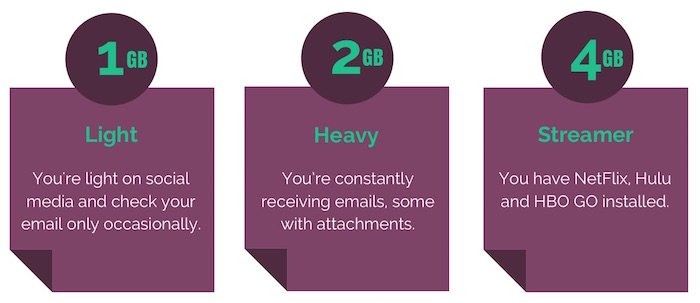
Light User
Recommended Data Plan: 1GB
As a light user, you probably check your email occasionally and do a bit of social media on your phone. You might upload a random snapshot here or there, but you tend to use your TV or computer for major tasks. You use your phone mostly for text messages and calls and since those don't use any data, you don’t need to worry much.
If this is you, you’re probably more than okay with a 1GB plan. In fact, if your carrier supports it, you’re probably rolling over a little data each month.
Heavy User
Recommended Data Plan: 2GB
The next group is the heavy users. You’re constantly receiving emails, some with attachments. You’re the first to catch the breaking trends on Twitter and your Pinterest boards are full of awesome shots. You play a few games and might even stream the occasional song or viral video. Your phone is a natural extension of your daily routine.
For you, you’re probably closer to the averages found in the previously mentioned studies. A 2GB plan will likely cover most of your usage, though, depending on pricing, a little more room might not hurt. Just be sure to keep an eye on your usage and you should be fine. We’ll break down how to do that in a moment.
Streamer
Recommended Data Plan: 4GB+
You have NetFlix, Hulu and HBO GO installed. Your list of subscriptions on YouTube is extensive. You’re even following your favorite bands on Spotify or have tweaked your Pandora stations to perfection. You play games on your phone, communicate with friends, video chat and send pictures regularly. Your phone is your fix to all of your entertainment and communications needs.
If this sounds like you, you’ll probably want to find a plan in the 4GB range. Depending on the speed of your connection and your Wi-Fi availability, you might even want a little more.
Monitor Your Usage & Fine Tune
Of course, the only true way to find the ideal plan is to keep track of your usage. While our estimates offer a good starting point, you always want to make sure you check back on your actual usage to ensure your plan is a good fit.
You could check your monthly statement. Or even average a few statements to get a more consistent result. But if you’re looking for something real-time, you’re best to go with your carrier's website or an app.
Most carriers now have their own apps for monitoring usage.
Android and iOS phones also include internal monitors in their operating system.

Here's how to find it:
- iOS: Settings > Cellular
- Android: Settings > Data usage
- Windows Phone: The built-in Data Sense app
If you want an in-depth look at what is using your data, warnings when you’re near your limit or other convenient additions, third-party apps are the way to go.
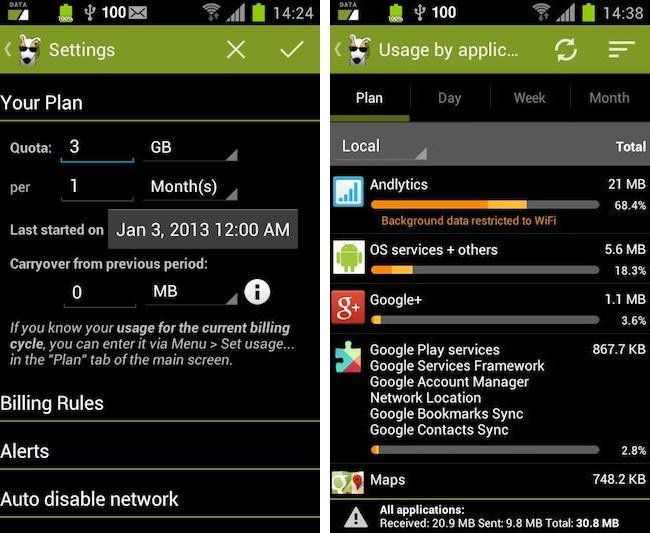 For an Android phone, 3G Watchdog Pro is a leading choice and costs less than a latte. Apple users can check out Data Usage Pro which has all the bells and whistles you could ever need for a small fee. Still sporting a BlackBerry? Impressive. Data Monitor has you covered. And lastly, Windows phone as mentioned above has the built-in Sense app.
For an Android phone, 3G Watchdog Pro is a leading choice and costs less than a latte. Apple users can check out Data Usage Pro which has all the bells and whistles you could ever need for a small fee. Still sporting a BlackBerry? Impressive. Data Monitor has you covered. And lastly, Windows phone as mentioned above has the built-in Sense app.
Bottom Line
As you’ve probably noticed, answering the question of "how much data do I need" depends heavily on how you use your phone. As screen resolutions and network speeds increase, usage is going to continue trending upward.
If you avoid streaming, you can cram a ton of phone time into only 1GB of data. Just take advantage of data monitoring apps and adjust your usage if you find yourself nearing your monthly limit.
If you plan to stream video at all, 2GB or more is highly recommended. It only takes two cute cat videos on Facebook or YouTube a day to throw you over 1GB of data by the end of a month.
With the cost of mobile data, you might want to think twice before clicking play while out and about. After all, if you can wait until you’re on Wi-Fi, streaming could cost you nothing at all!
Looking for further ways to save data and reduce the costs of smartphone ownership? Check out our comprehensive guide on how to save on your monthly data plan!
Your Turn
We hope this quick guide gave you everything you need to start finding the best data plan for your budget and needs. To ensure we’re always offering truly useful information we need your help! Here’s what you can do to get involved:
1. Ask Questions. Post them in the comments below.
2. Share Your Experience. Were our estimates close to your usage? Have a handy app or trick you use to keep your data wrangled? If you have anything to add, share it with others in the comments below. We'd love to hear from you!
3. Help Your Friends. If you think any of these tips would help out a friend, we'd appreciate it if you share this article with them on Facebook or Twitter. In helping them you help us in the process.
P.S. If you’re looking to squeeze the most out your data allowance, be sure to check out our full guide of Data Saving Tips.

